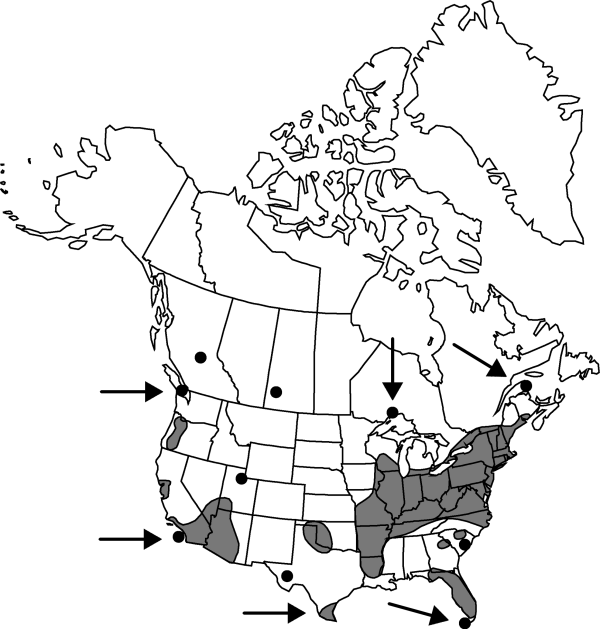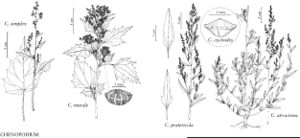Chenopodium murale
Sp. Pl. 1: 219. 1753.
Stems erect, branched, 1–6 (–10) dm, glabrous (to sparsely farinose when young); proximal branches decumbent. Leaves nonaromatic; petiole 1–2.5 cm; blade triangular, ovate, or rhombic-ovate, 0.8–4 (–8) × 0.4–3 (–5) cm, base cuneate to rounded, margins irregularly dentate, apex acute to acuminate, glabrous (rarely indistinctly farinose when young). Inflorescences glomerules in terminal and lateral panicles, 6–7 × 4–5 cm; glomerules subglobose, 2–4 mm diam., or some flowers not in glomerules; bracts absent. Flowers: perianth segments 5, distinct nearly to base; lobes ovate, 0.5–0.8 × 0.6–0.7 mm, apex acute to obtuse, keeled abaxially, farinose, covering fruit at maturity; stamens 5; stigmas 2, 0.2 mm. Achenes depressed-ovoid; pericarp adherent, pustulate, becoming smooth with maturity. Seeds lenticular, round, 1–1.5 mm diam.; seed-coat black, minutely rugose to ± smooth. 2n = 18.
Phenology: Fruiting fall.
Habitat: Waste places, roadsides, clay mounds, open oak woods, prairies, rocky hillsides, along railways
Elevation: 0-2000 m
Distribution

Introduced; B.C., N.B., Ont., Que., Sask., Ariz., Ark., Calif., Conn., Del., D.C., Fla., Ga., Ill., Ind., Ky., La., Maine, Md., Mass., Mich., Mo., Nev., N.J., N.Y., N.C., Ohio, Okla., Oreg., Pa., R.I., S.C., Tenn., Tex., Utah, Vt., Va., W.Va., Wis., native to Europe, Asia, n Africa, nearly worldwide, mostly in subtropics and warm-temperate regions
Discussion
Chenopodium murale is distinctive and is one of the more common species of the genus in the world, especially in tropical and subtropical regions.
Selected References
None.
Lower Taxa
"narrower" is not a number."thick" is not a number."dm" is not declared as a valid unit of measurement for this property."dm" is not declared as a valid unit of measurement for this property.
